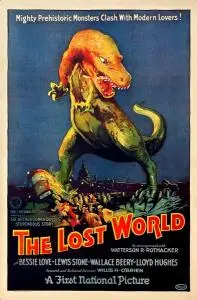How 'The Lost World' (1925) Unleashed Dinosaurs and Pioneered Sci-Fi Cinema's Roaring Potential!
In the annals of imaginative literature, few names shine as brightly or inspire as much adventurous spirit as Arthur Conan Doyle and Jules Verne. The French novelist, a true visionary of the 19th century, was far more than just a storyteller; he was a prophet of scientific marvels, propelling readers to the Journey to the Center of the Earth, Twenty Thousand Leagues Under the Seas, and Around the World in Eighty Days.
Sir Arthur Conan Doyle (1859-1930) stands as one of the most towering and enduring figures in the history of literature, whose influence extends far beyond the printed page into the very fabric of popular culture. Though he penned historical novels, science fiction, plays, poetry, and even advocated for spiritualism, it is his creation of Sherlock Holmes – the world's most famous consulting detective – that cemented his legendary status. Doyle didn't just write detective stories; he invented the blueprint for the modern crime procedural, introducing scientific deduction, forensic analysis, and a meticulously observed methodology that captivated readers and inspired countless imitators. Beyond Holmes, his adventurous spirit led him to craft other thrilling narratives, such as the prehistoric expedition in The Lost World, further showcasing his boundless imagination and his ability to transport readers to realms of both intricate logic and fantastic discovery. Doyle's legacy is one of intellect, adventure, and an unparalleled ability to forge characters and worlds that continue to fascinate and challenge new generations.
It's this spirit of thrilling scientific exploration and the discovery of the impossible that permeated the early 20th century, setting the perfect stage for the first major cinematic adaptation of Arthur Conan Doyle's parallel masterpiece, The Lost World (1925), a film that would, in turn, become a monumental cinematic achievement in its own right. The Lost World (1925) plunges us into an exhilarating, pioneering expedition that brings to life the impossible: living dinosaurs! The film follows the intrepid Professor Challenger (Wallace Beery), a fiercely determined and often cantankerous scientist, who presents astounding evidence of dinosaurs surviving on a remote, uncharted plateau in the Amazon basin. His radical claims are met with ridicule, forcing him to assemble a daring expedition to prove his theories. Joining him are the resourceful hunter John Roxton (Lewis Stone), the skeptical journalist Edward Malone (Lloyd Hughes), and the adventurous Paula White (Bessie Love), whose father disappeared on the plateau. What begins as a perilous journey into the heart of the Amazon transforms into an astonishing encounter with prehistoric life, as the team confronts a vibrant, dangerous ecosystem ruled by creatures thought long extinct, bringing awe and terror in equal measure.
Harry O. Hoyt's direction, under the visionary guidance of producer W.E. O'Brien, delivered a groundbreaking cinematic spectacle that transcended the limitations of its era. The film's immense historical significance lies primarily in its revolutionary use of stop-motion animation to bring the dinosaurs to life. Master animator Willis O'Brien (who would later work on King Kong) pioneered techniques that made these prehistoric creatures incredibly believable and menacing, engaging in thrilling battles and interacting seamlessly with live-action actors through ingenious split-screen effects. The sheer scale of the production, the ambitious set pieces, and the meticulous attention to detail in creature design created a truly immersive and awe-inspiring experience for audiences of the silent era. It wasn't just groundbreaking for its effects; it established a template for creature features and sci-fi adventure that echoed for decades, proving that special effects could be integral to storytelling.
The Lost World was a massive commercial and critical success, dazzling audiences worldwide with its "living" dinosaurs and thrilling adventure. It solidified the power of visual effects in storytelling and became a foundational cult film for sci-fi and monster movie enthusiasts. Wallace Beery delivers a commanding performance as Professor Challenger, perfectly embodying the eccentric, determined scientist. Lewis Stone and Bessie Love add a human dimension to the fantastic journey. The film's influence on later creature features, most notably King Kong (1933) and later Jurassic Park, is undeniable, making it a crucial landmark in cinema history. A true pioneer in special effects, it remains a testament to the boundless imagination that film could capture, proving that even a century ago, audiences craved a trip to the impossible.
Director: Harry O. Hoyt.
Cast: Wallace Beery as Professor Challenger, Bessie Love as Paula White, Lewis Stone as Sir John Roxton, Lloyd Hughes as Edward Malone, and Arthur Hoyt as Professor Summerlee.
Special Info/Trivia: This film is groundbreaking for its pioneering use of stop-motion animation by Willis O'Brien to bring dinosaurs to life. Willis O'Brien later went on to do the special effects for King Kong (1933). The film was based on Arthur Conan Doyle's 1912 novel of the same name. It was a major box office success and critically acclaimed for its special effects. The film's techniques had a profound influence on subsequent creature features and special effects. Some sequences were originally hand-colored for effect.

